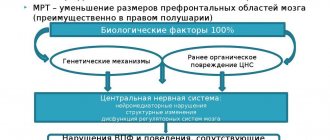Thursday, October 24, 2019
Inflammation of the bladder or cystitis can occur for various reasons. This disease significantly worsens the quality of life: a person experiences discomfort or even severe pain when urinating, pain in the lower abdomen, and a very frequent urge to urinate. There are simple rules to prevent illness, such as maintaining hygiene or avoiding hypothermia. And, nevertheless, you can get sick, even if you take care of your health, because this pathology can occur against the background of nervous overstrain - the so-called nervous or neurogenic cystitis.
What is neurasthenia and how does it develop?
Neurosis develops as a consequence of a disorder of the brain, namely the part that is responsible for human adaptation. The consequences of neuralgia can affect not only the mental and emotional state of the patient, but also negatively affect the functioning of various body systems and internal organs, since everything in the human body is interconnected.
Anxiety causes a strong release of adrenaline, which increases the secretion of pituitary hormones and insulin, which regulate the functioning of the thyroid gland. Such hormones increase the likelihood of panic attacks.
How to distinguish neurasthenia from other disorders?
People suffering from emotional distress experience various feelings more emotionally than others. Anger, anxiety, despair, aggression, envy - these are just some of the manifestations of neurosis in humans. During such conditions, the patient experiences an increased level of stress, so negative situations are perceived more acutely and seriously than they actually are.
Neurosis is based on traumatic circumstances, psychological trauma, stress or prolonged emotional and intellectual overstrain. Neurasthenia is often encountered by people who have recently experienced a serious emotional shock or the loss of loved ones.
People suffering from neurosis often deny their feelings, emotions, and try to distance themselves from their own reality. They find it difficult to control and manage their emotions. The disorder distorts the patient's rational thinking and does not allow him to function normally in the family, social and work spheres of life.
Sources
- Ilyina I.Yu., Dobrokhotova Yu.E. Features of urination in gynecological patients // MS. 2014. No. 19.
- Apolikhina I.A., Chochueva A.S., Saidova A.S., Gorbunova E.A. Modern possibilities of drug treatment of overactive bladder in women // MS. 2021. No. 2.
- Protoshchak V.V., Tsygan V.N., Shestaev A.Yu., Rassvetaev A.V., Kharitonov N.N., Matic A.I., Gulko A.M., Kulay D.G. Modern understanding of pathophysiology of nocturia // ECU. 2013. No. 3.
Symptoms of neurosis
Pathology manifests itself both at the physical and psycho-emotional levels. Physical symptoms include increased sweating, rapid heartbeat, chest pain and dry mouth, headaches, blurred vision, tremors of the limbs, skin rashes, and menstrual irregularities in women.
Psychological symptoms: a feeling of loss of control, a feeling that the person is “going crazy”, fear of sudden death, excessive worry, high sensitivity and vulnerability.
- Irritability;
- Constant feeling of fatigue and apathy;
- Increased sensitivity;
- Social isolation;
- Frequent and unexpected mood swings;
- Disturbances in sleep and wakefulness;
- Loss of interest in life or certain areas of it.
It is the constant feeling of anxiety for one’s life or the lives of loved ones that causes insomnia in a person. Problems with sleep do not allow the body and nervous system of those suffering from neurasthenia to fully rest. This, in turn, further intensifies all the symptoms listed above.
Therefore, for insomnia, experts recommend several simple and effective rules:
- Follow a daily routine, that is, try to fall asleep and wake up at the same time;
- Play sports, giving the body a light load;
- Be in the fresh air more often;
- Reduce the number of drinks containing caffeine;
- Eat light foods to avoid stomach discomfort.
For what reasons does neurosis develop?
- Strong mental activity;
- Prolonged psychological distress and anxiety;
- Psychological pressure due to the inability to solve life problems;
- Long-term loneliness and problems in the personal sphere of life;
- Traumatic event in life: loss of a loved one, difficult divorce, difficult financial situation, if the person has been subjected to emotional and physical abuse, etc.;
- High expectations. In this case, the person cannot achieve the desired goal and experiences a feeling of an impossible plan;
- Psychological trauma received in childhood: humiliation or beating from peers and parents, example of a bad lifestyle from adults, harsh upbringing;
- Failure to comply with work and rest schedules.
What can cause a child to stutter?
Organic causes
A number of reasons are associated with problems of early development and organic lesions of the nervous system:
- genetic predisposition;
- injuries during childbirth;
- intrauterine development disorders;
- infections that the mother suffered during pregnancy;
- diseases associated with metabolism in a pregnant mother;
- frequent ENT diseases of a child in the first 3 years of life.
In these cases, curing stuttering in a child is problematic. After all, it is caused by physiological abnormalities in the development of the nervous system. Children may have impaired reflexes, a tendency to seizures, and surges in intracranial pressure. Problems can be corrected with the help of medications that are selected by the doctor.
Acquired reasons
Basically, they are associated with stress and neuroses, due to which the child may begin to stutter. Most often this happens at 4-5 years of age, when the nervous system is most susceptible to external factors. Doctors include these:
- strong and frequent quarrels;
- life changes (for example, starting kindergarten);
- unfavorable atmosphere in the family;
- sharp fear;
- excessive intellectual stress;
- emotional turmoil;
- disordered life, child's daily routine.
Often, a child begins to stutter during the period of mastering his native language, when parents begin to intensively engage in its development. The brain does not have time to perceive the entire mass of information, especially if learning a foreign language is also added to the native language. Therefore, during any intellectual activities with your baby, it is important not to overload him. Particular attention should be paid to emotional children.
According to statistics, more than 80% of stuttering cases have acquired causes. Such children do not have any physiological abnormalities, and speech disorders can be corrected quite well.
Features of the course of neurosis in women
Neurosis is diagnosed in a third of the world's urban population. Neurology is one of the most common ailments of the nervous system—the disease occurs in every fourth person with mental illness. A study of the incidence of neurosis has shown that neurotic disorders are common in men and women over 30 years of age. However, neurotic disorders in women usually occur in a more severe form than in men.
The reason for such conclusions is the emotionality of women. Doctors note that neurosis most often appears in expressive and emotional people. According to statistics, women are more sensitive than men.
Experts also say that, unlike men, women suffer from neurosis almost twice as much. Menopause is considered one of the causes of neurosis in women. Any hormonal changes affect our nervous system and can bring unpleasant consequences.
Perhaps, in this case, a social factor also plays a role - men are less likely to go to doctors, especially to a psychotherapist. However, today experts say that the flow of men to psychotherapists has increased, but women are still more willing to go to a doctor for help.
Also, by the will of fate and centuries-old traditions, not only a career and daily work falls on a woman’s shoulders, but also cleaning the house and raising children. The modern woman has more tasks, the principle “you need to be strong and hold on” is firmly stuck in your head. However, this unknown force will not protect you from overload and fatigue. Then for help you need to contact a psychotherapist who will prescribe treatment. Psychotherapy sessions help to influence the cause of neurosis, change the attitude towards a traumatic situation and facilitate the release of emotions, accelerating recovery.
Symptoms of neurosis in women
The signs of neurosis in women differ from the opposite sex due to our physiological characteristics of the body. For example, among women the list of symptoms of neurosis includes insomnia, frequent nightmares and sleep paralysis, but this is not observed in men. Also, in women with neurosis, there is a deviation in the menstrual cycle.
Doctors identify the following most common symptoms of neurosis in women:
- anxiety;
- irritability;
- expressiveness of behavior;
- refusal to eat;
- impairment of physical qualities: loss of strength, feeling tired, loss of endurance;
- heart and headaches;
- vestibular disorders, balance disorders
- excessive tearfulness;
- sudden mood swings.
There are several types of neurosis, one of them is hysterical, most often called hysteria. According to doctors, signs of this type of disease are most often observed in women. Experts interpret hysterical disorder as an ardent desire to attract attention to the sick person. The disease is characterized by demonstrative behavior. A person suffering from such a disease often screams loudly, makes scandals, and sobs bitterly.
Medical psychotherapists have extensive experience and all the necessary resources for the successful treatment of neuroses.
Features of the course of neurosis in children
Neurasthenia is also common in children of primary and preschool age. Symptoms of the disorder are similar to those in adults. The difficulty in determining pathology lies only in the fact that young children often cannot explain what is happening to them and how they feel.
The child's appetite decreases, sleep problems appear, and nightmares often occur, as a result of which the baby may even cry out in his sleep and wake up without understanding what is happening. Increased sweating occurs and the temperature of the extremities decreases.
In addition to all the above signs of pathology, the child may have a headache, he is sensitive to bright light and loud sounds. There is also often a sharp change from positive emotions to negative ones: crying, aggression and depression.
Experts recommend immediately seeking help from a doctor, since neurosis in childhood is much more difficult to treat than in adults.
What types of neurosis exist and how do they differ?
- Depressive.
This type of neurosis is characterized by such symptoms in a person as tearfulness, sudden changes in mood, feelings of despair and helplessness. The person suffering from the disorder loses interest in life and becomes melancholy. During depressive neurosis, a person experiences low self-esteem, guilt, and frustration. - Anxious.
Often has manifestations at the physical level: dry mouth, increased sweating, rapid heartbeat. Anxiety neurosis can result in panic attacks and phobias. A person constantly experiences a feeling of fear. - Hysterical (“conversion disorder”)
- most often manifests itself if a person has experienced a strong emotional shock or a traumatic event. There is a change or loss of motor/sensory function indicating a physical disorder that is not detected. For example, after an accident, a person may experience loss of speech, although there is no physical reason for this. - Obsessive-compulsive.
Intrusive thoughts and images appear. Often such thoughts have no rational grain and are catastrophic in nature. To counter the overwhelming anxiety, a person performs compulsive, repetitive actions. - Rehearsal.
It manifests itself as attempts to resolve an issue that in the past remained unfinished. A person suffering from rehearsal neurosis transfers conflicting relationships from the past to the present and believes that this reality still exists today. - Hypochondriacal.
The patient becomes too suspicious and overly concerned about his health; he finds symptoms of various diseases where they actually do not exist. A person invents a terrible disease, torments himself, and stress or anxiety appears. Despite negative tests and consultations with doctors, the patient remains convinced of this. - Depersonalization.
Fear, panic and anxiety appear. It’s as if a person lives in a dream, “disconnecting” from his own body and thoughts. - Military or post-traumatic stress disorder.
It manifests itself under very shocking circumstances, when a person saw death or was captured or suffered serious injuries (physical and psychological). This type of neurasthenia is manifested by very strong stress, panic attacks, and an aggressive state. Such stress is dangerous because it can lead to disability, including functional disability that negatively affects daily life.
For example, a person believes that everyone treats him badly or no one likes him. As a result, he begins to behave in accordance with his ideas about others.
Neurosis and memory problems
Excessive anxiety leads to decreased concentration, which means that the patient often has problems with memory and attention. In order to influence the problem, you can take vitamin complexes of natural origin, as well as conduct useful memory training.
Experts recommend engaging in light physical activity and daily exercise to relieve anxiety and excessive worry.
Try not to multitask, this will only make the problem worse. It is better to remove all distractions while working or doing what you love. Such distractions include a mobile phone or any other mobile device. Turn them off when doing important things.
To reduce the strain on your eyes and brain, take breaks from work and study. Don't overwork yourself. You can take a walk in the fresh air or do some exercise.
Neurosis and psychosis: what is the difference?
Often these concepts are confused or interchanged. But diseases are different in their manifestations and the internal feeling of a person. For example, during the development of obsessive-compulsive neurosis, a person maintains a sense of reality and looks for new ways to adapt to it. He recognizes that he is suffering from a disorder and that this suffering is a product of mental instability.
During psychosis, a person perceives the world around him differently. He adapts reality according to his personal perception (often delusional), experiences hallucinations and delusions. And the main thing is how psychosis differs from neurosis: the patient is not aware of his problem.
Neurosis and vegetative-vascular dystonia
As we mentioned above, during neurosis signs appear on the physical level, such as rapid heartbeat, fluctuations in blood pressure, chest pain, difficulty breathing, etc. All these symptoms are similar to the signs of a disease such as vegetative-vascular dystonia.
VSD is a complex of symptoms of different localization that occur when there is a malfunction in the autonomic nervous system. And neurosis is a disorder of the central nervous system caused by the psyche (stress, depression, etc.). Since the nervous system is connected, disturbances in one department provoke disruptions in the functioning of another.
How is neurasthenia diagnosed?
To diagnose and identify the disease, you need to consult a neurologist, and sometimes a psychologist and psychiatrist. At the city clinic, you can contact your primary care physician, who will write a referral to a neurologist. However, this takes time. You often have to wait 2 weeks for an appointment with a doctor. In some cases, this is simply impossible, since it is necessary to quickly conduct an examination and prescribe treatment before the situation becomes critical.
Therefore, we recommend contacting the Medunion medical clinic. We employ practicing neurologists, and you don’t have to wait several weeks for appointments. Sign up today for a time convenient for you, not for the remaining time, and get tested tomorrow.
Patients choose us because we provide the service of a specialist coming to your home if you cannot come to the clinic on your own. You can also take samples directly at home.
Diagnosis includes interviewing the patient or his immediate family (guardians), collecting anamnesis and studying the medical history. To make a diagnosis, the doctor needs to know the symptoms that bother the patient.
To exclude other pathologies, the neurologist prescribes laboratory tests:
- Blood analysis;
- Analysis of urine;
- Ultrasonography;
- CT scan;
- Magnetic resonance imaging.
The specialist will also conduct psychological tests. For example, color technique. It consists in the fact that the patient is offered a palette of colors from which he must choose the color he likes. Colors such as purple, gray, red, brown, black indicate a high probability of developing neurosis.
Diagnostics
Finding out the causes of frequent urination begins with a thorough history taking. The doctor finds out how much the frequency of daytime and nighttime urges has increased, whether there are signs of urinary incontinence, pain or other symptoms.
To clarify the diagnosis, functional and laboratory tests are carried out:
- Ultrasound;
- CT;
- MRI;
- urogenital screening;
- blood test for PSA hormone;
- blood test for glucose levels;
- general urine analysis;
- urine analysis according to Nechiporenko;
- urine culture.
Research is necessary to determine the root cause of frequent urge to urinate, identify the causative agent of infection, and assess the severity of the inflammatory process, if present.
Methods for treating neurosis
Experts suggest fighting the disease using an integrated approach. This includes drug therapy, physical activity and proper nutrition, sleep and wakefulness, and moderate mental stress.
Drug therapy
Medicines, first of all, are antidepressants that are involved in the uptake of serotonin, dopamine, and norepinephrine. In addition, such drugs help block the enzyme that destroys these hormones. This allows you to increase their volume in the general bloodstream and thereby improve your mood.
These medications do not affect a person’s condition while driving a vehicle and are not addictive, but their effect occurs only a few weeks after the start of use. The duration of the course of therapy can reach 2-3 months.
There are also newer generation antidepressants that are considered safer and have fewer side effects. The duration of therapy and daily dose are determined only by the attending physician. Taking medications on your own without consulting a neurologist is highly undesirable.
Another effective remedy is drugs from the group of tranquilizers, which affect the transmission of nerve impulses in the brain, which makes it possible to slow down the activity of the nervous system and reduce a person’s reaction to a specific stimulus. The drugs have a sedative and anti-anxiety effect on the body.
Psychotherapeutic treatment
Personal psychotherapy allows a person suffering from a nervous disorder to build a picture of his personality and establish the cause that led to neurosis. A doctor helps change a person’s view of the world around him. Recovery occurs if the patient, with the help of a specialist, understands the cause of his fears and worries.
Meditation is also often used. With the help of psychoanalysis you can understand your inner world. Meditation can reduce anxiety and create new beliefs about specific situations.
Diet therapy
A proper diet during neurosis can reduce the load on the body. It is worth eating small portions 4-5 times a day, adding vegetables and fruits to your diet. They contain a high concentration of vitamins and fiber, which is a building material for all body systems.
It is also best to exclude sweets, flour, fried, and highly salty foods. Avoid strong and carbonated drinks. And also do not forget about the drinking regime, at least 1.5 liters of clean water per day.
Breathing exercises and massage
Physical exercise helps normalize the activity of parts of the brain such as the cortex and subcortex, as well as stimulate and calm the nervous system.
At the initial stage of gymnastics, simple exercises are performed that do not involve impact on the muscles and do not require concentration. Over time, the load must be increased. And breathing exercises improve blood circulation in the internal organs and in the brain, which allows you to get rid of pain.
Prevention of the development of neurosis
To prevent the development of neurosis, you need to exclude stressful situations and emotional overloads. Take breaks from work when you are doing heavy mental work.
Do things that are enjoyable and relaxing or soothing. Also suitable for prevention are meditations, which completely relax the body and mind and lift your spirits.
And don’t forget, if you feel constant panic attacks, a decline in emotional state, or other alarming symptoms of neurosis, consult a specialist.










